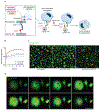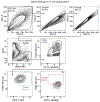CD24 signalling through macrophage Siglec-10 is a target for cancer immunotherapy
- PMID: 31367043
- PMCID: PMC6697206
- DOI: 10.1038/s41586-019-1456-0
CD24 signalling through macrophage Siglec-10 is a target for cancer immunotherapy
Abstract
Ovarian cancer and triple-negative breast cancer are among the most lethal diseases affecting women, with few targeted therapies and high rates of metastasis. Cancer cells are capable of evading clearance by macrophages through the overexpression of anti-phagocytic surface proteins called 'don't eat me' signals-including CD471, programmed cell death ligand 1 (PD-L1)2 and the beta-2 microglobulin subunit of the major histocompatibility class I complex (B2M)3. Monoclonal antibodies that antagonize the interaction of 'don't eat me' signals with their macrophage-expressed receptors have demonstrated therapeutic potential in several cancers4,5. However, variability in the magnitude and durability of the response to these agents has suggested the presence of additional, as yet unknown 'don't eat me' signals. Here we show that CD24 can be the dominant innate immune checkpoint in ovarian cancer and breast cancer, and is a promising target for cancer immunotherapy. We demonstrate a role for tumour-expressed CD24 in promoting immune evasion through its interaction with the inhibitory receptor sialic-acid-binding Ig-like lectin 10 (Siglec-10), which is expressed by tumour-associated macrophages. We find that many tumours overexpress CD24 and that tumour-associated macrophages express high levels of Siglec-10. Genetic ablation of either CD24 or Siglec-10, as well as blockade of the CD24-Siglec-10 interaction using monoclonal antibodies, robustly augment the phagocytosis of all CD24-expressing human tumours that we tested. Genetic ablation and therapeutic blockade of CD24 resulted in a macrophage-dependent reduction of tumour growth in vivo and an increase in survival time. These data reveal CD24 as a highly expressed, anti-phagocytic signal in several cancers and demonstrate the therapeutic potential for CD24 blockade in cancer immunotherapy.
Conflict of interest statement
Competing interests:
A.A.B. and I.L.W. are co-inventors on a patent application (62/684,407), which is related to this work. I.L.W. is a founder, director, stockholder, and consultant of FortySeven Inc., a cancer immunotherapy company.
Figures














Comment in
-
CD24 - a novel 'don't eat me' signal.Nat Rev Cancer. 2019 Oct;19(10):541. doi: 10.1038/s41568-019-0193-x. Nat Rev Cancer. 2019. PMID: 31406301 No abstract available.
-
CD24 - a novel 'don't eat me' signal.Nat Rev Drug Discov. 2019 Sep;18(10):747. doi: 10.1038/d41573-019-00146-0. Nat Rev Drug Discov. 2019. PMID: 31570841 No abstract available.
-
Innate immune checkpoints for cancer immunotherapy: expanding the scope of non T cell targets.Ann Transl Med. 2020 Aug;8(16):1031. doi: 10.21037/atm-20-1816. Ann Transl Med. 2020. PMID: 32953831 Free PMC article. No abstract available.
References
Publication types
MeSH terms
Substances
Grants and funding
LinkOut - more resources
Full Text Sources
Other Literature Sources
Molecular Biology Databases
Research Materials
Miscellaneous

